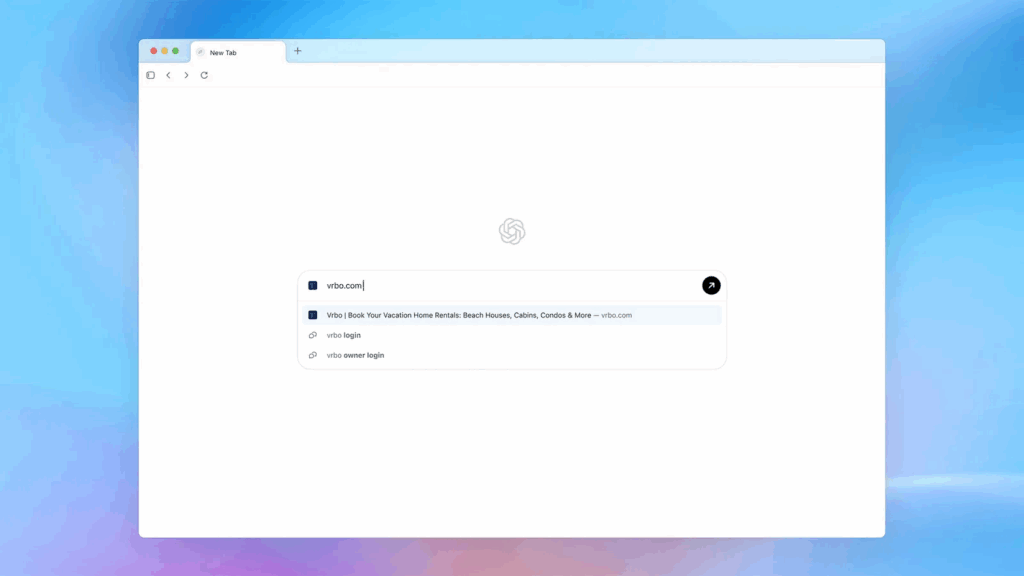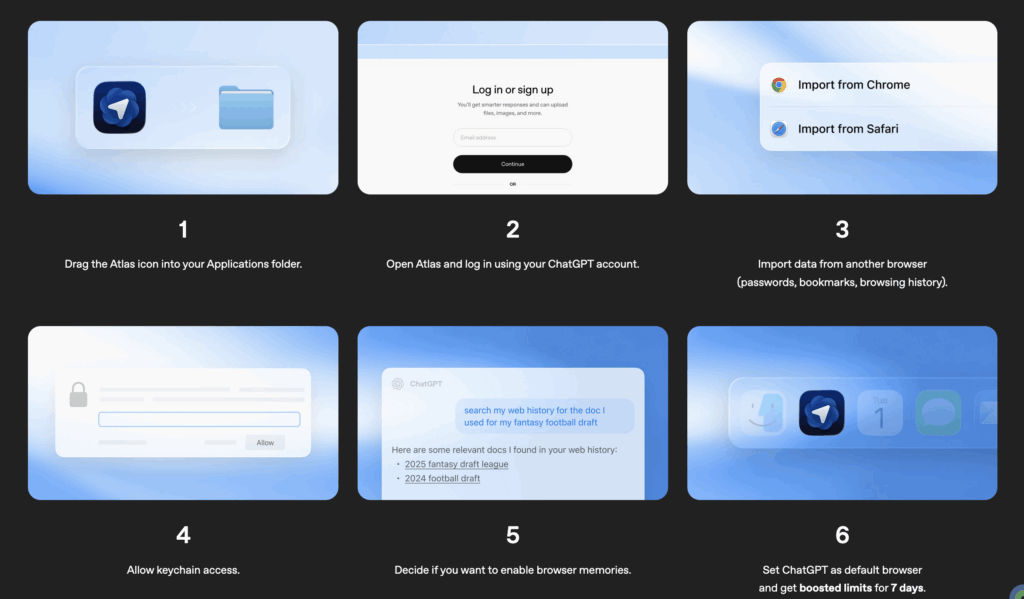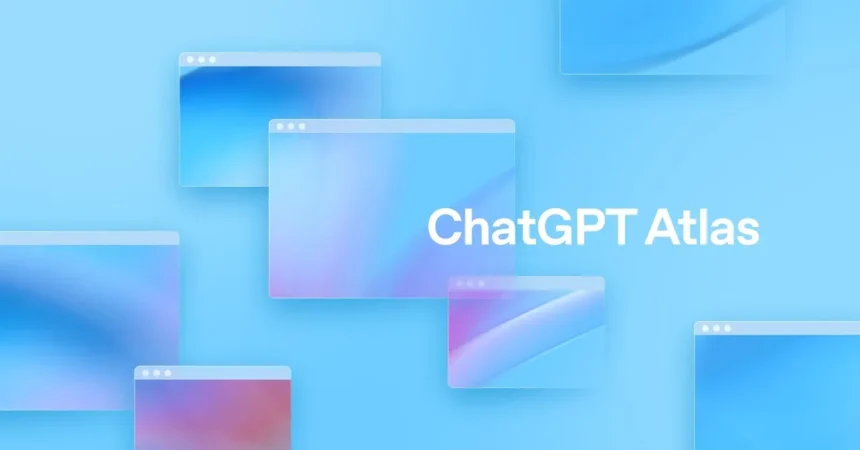The ChatGPT Browser That Thinks For You
OpenAI releases ChatGPT Atlas, an AI web browser it hopes redefines how users explore information. Atlas removes tabs, search bars, and bookmarks from the experience. Instead, it blends intelligence and browsing into one continuous dialogue.
Sam Altman, OpenAI’s CEO, introduces Atlas during a live demo. He calls it “the way people engage with the internet now.” Atlas acts as both browser and assistant. It reads, interprets, and responds within every web session.
Atlas runs on macOS first. Support for Windows, Android, and iOS follows soon. It integrates directly with ChatGPT Plus and Pro subscriptions. The product rolls out globally, including across Europe, where privacy laws challenge data-driven services.
What’s Happening & Why This Matters
The Browser Learns, Thinks, and Acts
ChatGPT Atlas eliminates friction. It turns browsing into conversation. Users highlight content and summon ChatGPT instantly. The AI summarizes, rewrites, or expands ideas without switching tabs.
A constant “Ask ChatGPT” button sits inside the window. It analyzes any page on command. The sidebar explains articles, debugs code, or generates responses that match context. No app-switching, no clutter — just the internet through conversation.

Atlas runs on Google’s Chromium engine, ensuring compatibility with existing extensions and tools. It supports passwords, bookmarks, and privacy settings but overlays AI across every function. The browser learns from interaction, adapting to user rhythm and tone.
Memory and Agent Mode Change Everything
Atlas introduces Memory and Agent Mode, two new power systems that give ChatGPT presence and purpose.
Memory stores contextual data from browsing sessions. It recognizes projects, recalls previous conversations, and personalizes experiences. It remembers shopping lists, notes, and research topics. It keeps this information separate from cookies or tracking systems. Passwords, payments, and personal data remain under user control.

Agent Mode turns ChatGPT into a digital actor. It performs online tasks with permission — ordering groceries, managing documents, scheduling events, or compiling reports. During the product demonstration, ChatGPT found recipes, selected ingredients, logged into Instacart, and built a shopping cart autonomously.
Access to Agent Mode remains limited to ChatGPT Plus and Pro tiers. OpenAI enforces strict boundaries. Atlas interacts only with browser tabs. It lacks permission to execute external code or alter system files. Users retain full authority. Tasks stop instantly on user command.
Altman explains the design as “building an assistant that knows context and respects intent.”
Privacy, Trust, and Parental Settings
OpenAI positions Atlas as privacy-first. ChatGPT browsing data remains outside its model training pipeline. Memories and sessions stay local and deletable. The interface includes options for Incognito Mode, history clearance, and parental oversight.
Existing ChatGPT parental settings extend directly into Atlas. Guardians restrict memory collection or disable Agent Mode entirely. This level of control defines Altman’s concept of responsible AI — one that functions helpfully without intrusion.
Enter the New Browser Wars
The release of Atlas reopens an old contest. Google Chrome controls 71% of browser traffic. Apple Safari ranks second. Yet both now face an existential challenge: AI-native navigation.
Microsoft Edge integrates Copilot AI into Windows. Google Gemini embeds generative tools into Chrome. Startups such as Perplexity AI merge search, action, and summarization into single results.
Atlas separates itself from all three by merging AI, browsing, and interaction into a unified framework. No search query. No passive reading. Atlas understands intent and acts instantly.
It represents the next competitive tier — the conversational internet. The browser stops being a window. It becomes an interface of thought.
The Experience Feels Different
The Atlas layout feels minimalist. The design favors clarity. Its color scheme echoes the ChatGPT app — dark, neutral, clean. Prompts live directly inside the navigation bar. Content loads under guidance rather than user guesswork.
Each response feels conversational. The AI references page material directly, rather than dumping links. Users test information, request revisions, or build entire research drafts in minutes.
Developers, writers, marketers, and students already use ChatGPT. Atlas binds all those workflows to the open web. It creates continuity between creation and discovery.
Altman calls the product “a knowledge companion, not a search engine.” That phrase defines OpenAI’s ambition. It doesn’t compete for clicks. It competes for comprehension.
The Broader Stakes for OpenAI
OpenAI’s growth strategy becomes clear. ChatGPT dominates dialogue. Sora expands into video generation. Whisper handles audio. Atlas completes the ecosystem with browsing.
The company embraces full-stack human-computer symbiosis — where every digital act connects through ChatGPT. Each product adds a layer of context and control. Together, they create the AI operating environment that defines OpenAI’s identity.
Competitors scramble to respond. Google strengthens Gemini Advanced integration. Microsoft deepens ties between Copilot and Office 365. Yet both rely on search-driven logic. Atlas departs from that model entirely. It trades search for synthesis.
TF Summary: What’s Next
Atlas rewires the web. The internet stops being a place to browse. It becomes a dialogue. The browser acts, reasons, and learns. Each click transforms into context. Each query becomes creation.
MY FORECAST: OpenAI expands ChatGPT’s domain beyond text and images into interactive intelligence. Atlas is a gateway to a conversational web — one defined by understanding, action, and memory. Chrome once symbolized speed. Safari once symbolized design. Atlas symbolizes cognition.
— Text-to-Speech (TTS) provided by gspeech


